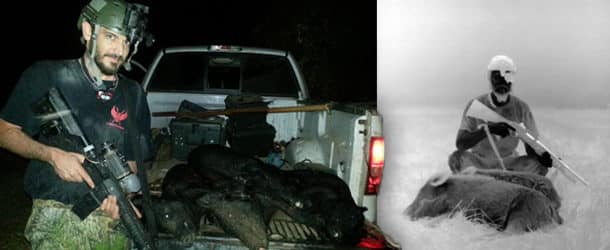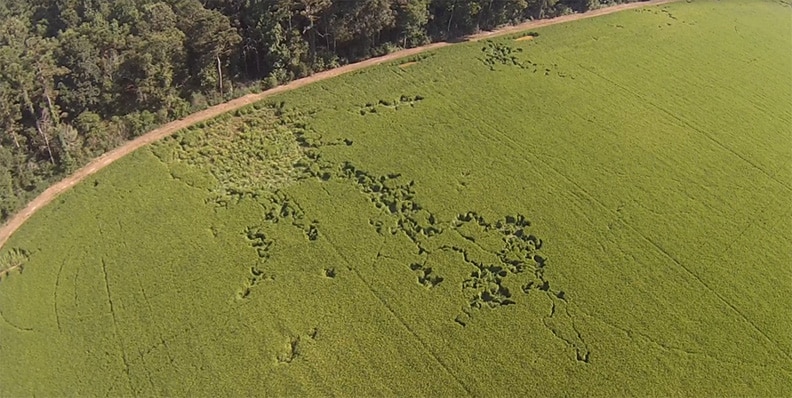Here’s What Happened When A Lafayette Man Used A Drone To Save His Brother’s Farm From Feral Hogs
BY BRAD GOINS
Several years back, Cy Brown of Lafayette found himself in a predicament when his brother bought a new property that he turned into a rice farm. His brother had encountered a big problem with the new farm, which abutted Chicot State Park.
So just what was the problem? It turned out that Chicot State Park had more than its fair share of feral hogs.
Brown says feral hogs “trashed” the rice fields of his brother’s farm at night. The brother was at the point of giving up the business.
What sort of damage were the hogs doing to the fields? Brown says that while they ate some rice in their initial nocturnal visits, they were mainly interested in rolling around in the rice plants (and, of course, crushing them in the process). Brown theorizes that this behavior constitutes a sort of self-massage for the hogs, whose skin is unusually rough.
He said the hogs liked to “mash [the rice] down into the water; come back; and eat it later.” Hogs seemed to prefer the taste of rice that had been soaking in water for a while.
Initial efforts to chase down the hogs and kill them failed. One major difficulty was that the high grass of mature rice fields was taller than most of the hogs. The animals in the fields simply couldn’t be seen.
Brown hit upon the idea of attaching a thermal camera to a drone and sending the drone over the rice fields at night. The thermal camera pinpointed the location of the pigs by detecting their body heat. Using a method called “first person viewing,” Brown would be able to determine where the hogs were located and direct the hunter or hunters to that location.
Even with the aid of a drone and thermal camera, it’s still “very difficult to locate” the hogs in “waist-high grass” that’s extremely dense, says Brown. In some cases, the drone camera can’t pick up the heat from small pigs. Brown says there have been times when he’s almost stepped on an unseen hog at night.
It was more than just the height of the grass that created problems for the rice farmer. The basic configuration of rice fields gives feral hogs places to hide; to assemble in large numbers; and to move quickly. In his brother’s farm, says Brown, “there’s a levee and ditch every 100 yards.” (I am assuming that no farmer would want to have feral hogs do a number on a levee.)
Not every farmer finds the feral hog invasion as overwhelming as Brown’s brother did. “Sometimes a drone isn’t necessary,” says Brown. For instance, peanut farmers have a much easier time of locating feral hogs because peanut plants aren’t very tall. But even in cases where feral hogs might be seen by eye, says Brown, “you can cover a lot more ground quicker” with a drone.
Before Brown began to use the drone and thermal camera, he says that he and those who worked with him on his brother’s farm were “lucky to get two out of 10 [hogs] in a night. After the method was employed, “we went from zero to a handful [of hogs] each night.” With the gradual elimination of a small number of hogs each night, the population of invading hogs eventually decreased significantly.
The problem wasn’t entirely solved. But it did become manageable. And Brown’s brother was able to keep his farm running.
But Then There Was A New Problem …
Much ink has been spilled about what rules the FAA might or might not have about the relation between drones and hunting. For many, the topic appears to be in shades of gray rather than black and white. As Brown puts it, “It’s kind of the Wild West as far as drones are concerned.”
That was demonstrated in 2013, when the FAA went “on the warpath” against Brown’s operation. The organization may have learned about Brown’s work through an article that appeared in Time magazine, or in articles on the project in several other prominent periodicals.
The FAA subpoenaed Brown in 2013. He was told that while it was acceptable to fly a drone if one did so as a “hobbyist,” one could not have the hobby of drone flying and at the same time make money from drone flying. At the time, Brown ran a business called Louisiana Hog Control. The FAA maintained that it was not legal for Brown to use drones to locate hogs when he was also running the business.
In another, more vague, principle, the FAA stated that drone flyers could not “mix hobbies” with drones. Presumably, one could not mix the hobby of drone flying with the hobby of hunting.
Having been subpoenaed, Brown was, of course, obliged to hire an attorney. The case was finally resolved in 2014. As part of the settlement, Brown agreed to end his business Louisiana Hog Control. For its part, the FAA stated it would not “pursue enforcement” against Brown.
The organization gave Brown a new set of rules. It had dropped the prohibition against mixing hobbies. Brown was now considered purely a “hobbyist.”
Success … For Now
Brown continues to use the drone/thermal camera method when he feels it’s necessary. He says that feral hogs are “now rarely even there” in his brother’s fields. But he feels “there’s always new” hogs on the way.
Feral hogs can be scared away for a period ranging from a few weeks to as long as a year. But eventually, they’ll forget what they were once afraid of and return to the ground cover they find so tempting.
Brown doesn’t feel he’s doing anything elaborate or exotic or wildly experimental. “I’m not the only guy doing this,” he says. “It’s easy buying these things off the shelf.”
Not A Question Of ‘Fair Chase’
At present, there’s a fair amount of controversy about the use of drones in any activity that’s related to hunting. Brown wants to make sure he doesn’t get caught in the cross fire.
First things first. Brown is emphatic on one point in particular: “The drone is positively, absolutely not armed.” It is what Brown calls a “remote-controlled airplane.”

For Brown, what he does with feral hogs has nothing to do with the traditions that apply to hunting deer. Feral hogs are pests and nothing more. They are not to be treated as game.
“It’s not ‘fair chase,'” he says. “This isn’t hunting. It’s extermination. They’re like overgrown roaches. Every one we can kill, we will.”
Brown has no interest in giving special breaks to infant feral hogs. They are to be eliminated just like all the others.
In legal terms, while there are some regulations regarding feral hogs, there is no limit for them.
For now, Brown’s brother’s fields are calm and he’s made his peace with the FAA. But the debate about the many issues that arise from the connection of drones with practices that have some relation to hunting is just beginning. To take just one instance: is it considered “fair chase” if a potential hunter uses a drone to scout game in an area several days before he hunts in the area?
Drones are new technology, and they’re new technology that much of the public has mastered. They’re one new technology government bureaucracy is way behind the swing on. We’ll have to wait and see what transpires while the bureaucracy catches up with everyone else.

















Comments are closed.